Brazil
| Federative Republic of Brazil República Federativa do Brasil | ||||||
|---|---|---|---|---|---|---|
| ||||||
| Motto: "Ordem e Progresso" (Portuguese) "Order and Progress" | ||||||
| Anthem: Hino Nacional Brasileiro (Portuguese) "National Anthem of Brazil" | ||||||
| National seal Selo Nacional do Brasil (Portuguese) "National Seal of Brazil" | ||||||
 | ||||||
| Capital | Brasília | |||||
| Largest city | São Paulo | |||||
| Official languages | Portuguese | |||||
| Ethnic groups | 49.7% White 42.6% Pardo (Brown) 6.9% Black 0.5% Asian 0.3% Amerindian | |||||
| Demonym | Brazilian | |||||
| Government | Presidential Federal republic | |||||
| - | President | Luiz Inácio Lula da Silva | ||||
| - | Vice-President | José Alencar | ||||
| - | President of the Chamber of Deputies | Arlindo Chinaglia | ||||
| - | President of the Senate | Garibaldi Alves Filho | ||||
| - | Chief Justice | Gilmar Mendes | ||||
| Independence | from Portugal | |||||
| - | Declared | September 7, 1822 | ||||
| - | Recognized | August 29, 1825 | ||||
| - | Republic | November 15, 1889 | ||||
| Area | ||||||
| - | Total | 8,514,877 km2 (5th) 3,287,597 sq mi | ||||
| - | Water (%) | 0.65 | ||||
| Population | ||||||
| - | 2008 estimate | 190,320,258 (5th) | ||||
| - | 2007 census | 189,987,291 | ||||
| - | Density | 22/km2 (182nd) 57/sq mi | ||||
| GDP (PPP) | 2007 estimate | |||||
| - | Total | $1,837 trillion[1] (9th) | ||||
| - | Per capita | $9,703[1] (61st) | ||||
| GDP (nominal) | 2007 estimate | |||||
| - | Total | $1,313 trillion[1] (10th) | ||||
| - | Per capita | $6,937[1] (63rd) | ||||
| Gini (2004[3][4]) | 57.0[2] | |||||
| HDI (2005) | 0.800 (high) (70th) | |||||
| Currency | Real (R$) (BRL) | |||||
| Time zone | BRT [5] (UTC-2 to -4[6]) | |||||
| - | Summer (DST) | BRST [7] (UTC-2 to -5) | ||||
| Drives on the | right | |||||
| Internet TLD | .br | |||||
| Calling code | 55 | |||||
Brazil (Portuguese: Brasil), officially the Federative Republic of Brazil (Portuguese: República Federativa do Brasil) listen , is a country in South America.[8] It is the fifth largest country by geographical area, occuping nearly half of South America,[9] the fifth most populous country, and the fourth most populous democracy in the world.[8][10] Bounded by the Atlantic Ocean on the east, Brazil has a coastline of over 7,491 kilometers (4,655 mi).[8] It is bordered on the north by Venezuela, Suriname, Guyana and the overseas department of French Guiana; on the northwest by Colombia; on the west by Bolivia and Peru; on the southwest by Argentina and Paraguay and on the south by Uruguay. Numerous archipelagos are part of the Brazilian territory, such as Fernando de Noronha, Rocas Atoll, Saint Peter and Paul Rocks, and Trindade and Martim Vaz.[8]
Brazil was a colony of Portugal from the landing of Pedro Álvares Cabral in 1500 until its independence in 1822.[11] Initially independent as the Brazilian Empire, the country has been a republic since 1889, although the bicameral legislature; now called Congress, dates back to 1824, when the first constitution was ratified.[11] Its current Constitution defines Brazil as a Federal Republic.[12] The Federation is formed by the union of the Federal District, the 26 States, and the 5,564 Municipalities.[12][13]
Brazil is the world's tenth largest economy at market exchange rates and the ninth largest in purchasing power.[14] Economic reforms have given the country new international projection.[15] It is a founding member of the United Nations and the Union of South American Nations. A Roman catholic, Portuguese-speaking, and multiethnic society,[10] Brazil is also home to a diversity of wildlife, natural environments, and extensive natural resources in a variety of protected habitats.[8]
Contents1 History
|
History
Origins
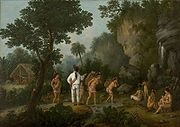
Most native peoples who live and lived within Brazil's current borders are thought to descend from the first wave of migrants from North Asia (Siberia) that crossed the Bering Land Bridge at the end of the last Ice Age around 9000 BC. In 1500 AD, the territory of modern Brazil had an estimated total population of nearly 3 million Amerindians divided in 2,000 nations and tribes.
A not-updated linguistic survey found 188 living indigenous languages with 155,000 total speakers. In 2007, Fundação Nacional do Índio (English: National Indian Foundation) reported the presence of 67 different tribes yet living without contact with civilization, up from 40 in 2005. With this figure, now Brazil has the largest number of uncontacted peoples in the World, even more than the island of New Guinea. When the Portuguese arrived in 1500, the Amerindians were mostly semi-nomadic tribes, with the largest population living on the coast and along the banks of major rivers. Unlike Christopher Columbus who thought he had reached the India, the Portuguese Vasco da Gama had already reached India sailing around Africa two years before they reached Brazil.
Nevertheless, the word índios ("Indians") was by then established to designate the peoples of the New World and stuck being used today in the Portuguese language, while the people of India are called indianos. Initially, the Europeans saw the natives as noble savages, and miscegenation of the population began right away. Tribal warfare and cannibalism convinced the Portuguese that they should "civilize" the Amerindians.[16]
Colonization

Initially Portugal had little interest in Brazil, mainly because of the high profits to be gained from its commerce with India, Indochina, China and Japan. Brazil's only economic exploitation was the pursuit of brazilwood. for its treasured red dye. From 1530 the Portuguese Crown devised the Hereditary Captaincies system to effectively occupy its new colony, and later took direct control of the failed captaincies.[17] Although temporary trading posts were established earlier to collect brazilwood, with permanent settlement came the establishment of the sugarcane industry and its intensive labor. Several early settlements were founded along the coast, among them the colonial capital, Salvador, established in 1549 at the Bay of All Saints in the north, and the city of Rio de Janeiro on March 1567, in the south. The Portuguese colonists adopted an economy based on the production of agricultural goods for export to Europe. Sugar became by far the most important Brazilian colonial product until the early 18th century.[18][19] Even though Brazilian sugar was reputed to be of high quality, the industry faced a crisis during the 17th and 18th centuries when the Dutch and the French started to produce sugar in the Antilles, located much closer to Europe, causing sugar prices to fall.
During the 17th century, private explorers from São Paulo Captaincy, now called Bandeirantes, explored and expanded Brazil's borders, mainly while raiding the hinterland tribes to enslave Native Brazilians. In the 18th century, the Bandeirantes found gold and diamond deposits in the modern-day state of Minas Gerais. Profits from the development of these deposits were mostly used to finance the Portuguese Royal Court's expenditure on the preservation of its Global Empire and the support of its luxurious lifestyle. The way in which such deposits were exploited by the Portuguese Crown and the powerful local elites burdened colonial Brazil with excessive taxation, giving rise to some popular independence movements such as the Tiradentes in 1789; however, the secessionist movements were often dismissed by the colonial authorities. Gold production declined towards the end of the 18th century, beginning a period of relative stagnation in Brazil's hinterland.[20] Both Amerindian and African slaves' man power were largely used in Brazil's colonial economy.[21]
In contrast to the neighboring Spanish possessions in South America, the Portuguese colony of Brazil kept its territorial, political and linguistic integrity, due to the efforts of the colonial Portuguese administration. Although the colony was threatened by other nations during the era of Portuguese rule, in particular by the Dutch and the French, the authorities and the people ultimately managed to protect its borders from foreign attacks. Portugal even sent bullion to Brazil, a spectacular reversal of the colonial trend, in order to protect the integrity of the colony.[22]
Empire

In 1808, the Portuguese court, fleeing from Napoleon’s troops who had invaded Portugal, established themselves in the city of Rio de Janeiro, which thus became the seat of government of Portugal and the entire Portuguese Empire, even though being located outside of Europe. Rio de Janeiro was the capital of the Portuguese empire from 1808 to 1815. After that, the United Kingdom of Portugal, Brazil and the Algarves (1815–1825) was created with Lisbon as its capital. After João VI returned to Portugal in 1821, his heir-apparent Pedro became regent of the Kingdom of Brazil, within the United Kingdom of Portugal, Brazil and the Algarves. Following a series of political incidents and disputes, Brazil achieved its independence from Portugal on 7 September 1822. On 12 October 1822, Dom Pedro became the first Emperor of Brazil, being crowned on 1 December 1822. Portugal would recognize Brazil as an independent country in 1825.
In 1824, Pedro closed the Constituent Assembly, stating that the body was "endangering liberty". Pedro then produced a constitution modeled on that of Portugal (1822) and France (1814). It specified indirect elections and created the legislative, executive and judicial branches of government; however, it also added a fourth branch, the "moderating power", to be held by the Emperor. Pedro's government was considered economically and administratively inefficient. Political pressures eventually made the Emperor step down on 7 April 1831. He returned to Portugal leaving behind his five-year-old son Pedro II. Until Pedro II reached maturity, Brazil was governed by regents from 1831 to 1840. The regency period was turbulent and marked by numerous local revolts including the Male Revolt, the largest urban slave rebellion in the Americas, which took place in Bahia in 1835.[23]
On 23 July 1840, Pedro II was crowned Emperor. His government was marked by a substantial rise in coffee exports, the War of the Triple Alliance, and the end of slave trade from Africa in 1850, although slavery in Brazilian territory would only be abolished in 1888. By the Eusébio de Queirós law,[24] Brazil stopped trading slaves from Africa in 1850. Slavery was abandoned altogether in 1888, thus making Brazil the last country of the Americas to ban slavery.[25][26] When slavery was finally abolished, a large influx of European immigrants took place.[27][28][29] By the 1870s, the Emperor's control of domestic politics had started to deteriorate in the face of crises with the Catholic Church, the Army and the slaveholders. The Republican movement slowly gained strength. The dominant classes no longer needed the empire to protect their interests and deeply resented the abolition of slavery.[30] Indeed, imperial centralization ran counter to their desire for local autonomy. By 1889 Pedro II had stepped down and the Republican system had been adopted in Brazil. In the end, the empire really fell because of a coup d'état.
Republic
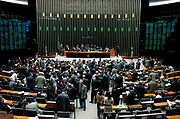
Pedro II was deposed on November 15, 1889 by a Republican military coup led by general Deodoro da Fonseca,[31] who became the country’s first de facto president through military ascension. The country’s name became the Republic of the United States of Brazil. From 1889 to 1930, the dominant states of São Paulo and Minas Gerais alternated control of the presidency.[32][33] A military junta took control in 1930. Getúlio Vargas took office soon after, and would remain as dictatorial ruler until 1945. He was re-elected in 1951 and stayed in office until his suicide in 1954. After 1930, successive governments continued industrial and agricultural growth and the development of the vast interior of Brazil.[33][34] Juscelino Kubitschek's office years (1956-1961) were marked by the political campaign motto of plunging "50 anos em 5" (English: fifty years of development in five).[35]
The military took office in Brazil in a coup d'état in 1964, and remained in power until March 1985, when it fell from grace because of political struggles between the regime and the Brazilian elites. In 1967 the name of the country was changed to Federative Republic of Brazil. Just as the Brazilian regime changes of 1889, 1930, and 1945 unleashed competing political forces and caused divisions within the military, so too did the 1964 regime change.[36] Democracy was re-established in 1988 when the current Federal Constitution was enacted.[37] Fernando Collor de Mello was the first president truly elected by popular vote after the military regime.[38] Collor took office in March 1990. In September 1992, the National Congress voted for Collor's impeachment after a sequence of scandals were uncovered by the media.[38][39] The vice-president, Itamar Franco, assumed the presidency. Assisted by the Minister of Finance at that time, Fernando Henrique Cardoso, Itamar Franco's administration implemented the Plano Real economic package,[38] which included a new currency temporarily pegged to the U.S. dollar, the real. In the elections held on October 3, 1994, Fernando Henrique Cardoso ran for president and won, being reelected in 1998. Brazil's current president is Luiz Inácio Lula da Silva, elected in 2002 and reelected in 2006.
Government and politics

The Brazilian Federation is based on the union of three autonomous political entities: the States, the Municipalities and the Federal District.[12] A fourth entity originated in the aforementioned association: the Union.[12] There is no hierarchy among the political entities. The Federation is set on six fundamental principles:[12] sovereignty, citizenship, dignity of the people, social value of labor, freedom of enterprise, and political pluralism. The classic tripartite branches of government (executive, legislative, and judicial under the checks and balances system), is formally established by the Constitution.[12] The executive and legislative are organized independently in all four political entities, while the judiciary is organized only in the federal and state levels.
All members of the executive and legislative branches are directly elected.[40][41][42] Judges and other judicial officials are appointed after passing entry exams.[40] Voting is compulsory for those aged 18 or older.[12] Four political parties stand out among several small ones: Workers' Party (PT), Brazilian Social Democracy Party (PSDB), Brazilian Democratic Movement Party (PMDB), and Democrats (formerly Liberal Front Party - PFL). Almost all governmental and administrative functions are exercised by authorities and agencies affiliated to the Executive.
The form of government is that of a democratic republic, with a presidential system.[12] The president is both head of state and head of government of the Union and is elected for a four-year term,[12] with the possibility of re-election for a second successive term. The current president is Luiz Inácio Lula da Silva. He was elected on October 27, 2002,[43] and re-elected on October 29, 2006.[44] The President appoints the Ministers of State, who assist in governing.[12] Legislative houses in each political entity are the main source of laws in Brazil. The National Congress is the Federation’s bicameral legislature, consisting of the Chamber of Deputies and the Federal Senate. Judiciary authorities exercise jurisdictional duties almost exclusively.
Law

Brazilian law is based on Roman-Germanic traditions.[45] Thus, civil law concepts prevail over common law practices. Most of Brazilian law is codified, although non-codified statutes also represent a substantial part of the system, playing a complementary role. Court decisions set out interpretive guidelines; however, they are not binding on other specific cases except in a few situations. Doctrinal works and the works of academic jurists have strong influence in law creation and in law cases. The legal system is based on the Federal Constitution, which was promulgated on 5 October 1988, and is the fundamental law of Brazil. All other legislation and court decisions must conform to its rules.[46] As of April 2007, there have been 53 amendments. States have their own constitutions, which must not contradict the Federal Constitution.[47] Municipalities and the Federal District do not have their own constitutions; instead, they have "organic laws" (leis orgânicas).[12][48] Legislative entities are the main source of statutes, although in certain matters judiciary and executive bodies may enact legal norms.[12]
Jurisdiction is administered by the judiciary entities, although in rare situations the Federal Constitution allows the Federal Senate to pass on legal judgments.[12] There are also specialized military, labor, and electoral courts.[12] The highest court is the Supreme Federal Tribunal. This system has been criticised over the last decades due to the slow pace at which final decisions are issued. Lawsuits on appeal may take several years to resolve, and in some cases more than a decade elapses before definitive rulings are made.[49]
Foreign relations and the military
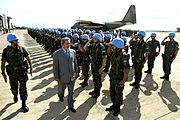
Brazil is a political and economic leader in Latin America.[50][51] However, social and economic problems prevent it from becoming an effective global power.[52] Between World War II and 1990, both democratic and military governments sought to expand Brazil's influence in the world by pursuing a state-led industrial policy and an independent foreign policy. More recently, the country has aimed to strengthen ties with other South American countries, engage in multilateral diplomacy through the United Nations and the Organization of American States.[53] Brazil's current foreign policy is based on the country's position as a regional power in Latin America, a leader among developing countries, and an emerging world power.[54] Brazilian foreign policy has generally reflected multilateralism, peaceful dispute settlement, and nonintervention in the affairs of other countries.[55] The Brazilian Constitution also determines the country shall seek the economic, political, social and cultural integration of the nations of Latin America.[12][56][57][58]
The Armed forces of Brazil comprise the Brazilian Army, the Brazilian Navy, and the Brazilian Air Force.[12] The Military Police (States' Military Police) is described as an ancillary force of the Army by constitution, but under the control of each state's governor.[12] The Brazilian armed forces are the largest in Latin America. The Brazilian Air Force is the aerial warfare branch of the Brazilian armed forces, the largest air force in Latin America, with about 700 manned aircraft in service.[59] The Brazilian Navy is responsible for naval operations and for guarding Brazilian territorial waters. It is the oldest of the Brazilian Armed forces and the only navy in Latin America to operate an aircraft carrier, the NAeL São Paulo (formerly FS Foch of the French Navy).[60] Finally, the Brazilian Army is responsible for land-based military operations, with a strength of approximately 190,000 soldiers.
Subdivisions
|
Atlantic Ocean Pacific Ocean North Region Northeast Region Central-West Region Southeast Region South Region Acre Amazonas Pará Roraima Amapá Rondônia Tocantins Maranhão Bahia Piauí Ceará Rio Grande do Norte Paraíba Pernambuco Alagoas Sergipe Mato Grosso Mato Grosso do Sul Federal District Goiás Minas Gerais São Paulo Rio de Janeiro Espírito Santo Paraná Santa Catarina Rio Grande do Sul Argentina Bolivia Chile Colombia French Guiana Guyana Paraguay Peru Suriname Uruguay Venezuela |
According to the Brazilian Constitution of 1988, Brazil is a federation of 26 states (estados), one federal district (Distrito Federal) and, also, the municipalities. None of these units have the right to secede from the Federation.[12]
States are based on historical, conventional borders and have developed throughout the centuries; though some boundaries are arbitrary. The states can be split or joined together in new states if their people express so in a plebiscite. States have autonomous administrations, collect their own taxes and receive a share of taxes collected by the Union government. They have a governor and legislative body (Assembléia Legislativa) elected directly by their people. They also have independent Courts of Law for common justice. Despite that, states are not so free to create their own laws as in the United States. For example, criminal and civil laws can only be voted by the Brazilian bicameral Congress.[12]
Municipalities can be split or joined together in new municipalities if their people express so in a plebiscite, following some rules of the Federal Constitution and keeping the border within the former state. Municipalities have autonomous administrations, collect their own taxes and receive a share of taxes collected by the Union and state government.[12] They have a mayor (prefeito) and a legislative body (Câmara de Vereadores) elected directly by their people, but they have no separated Courts of Law. Indeed, a Court of Law organized by the state can encompass many municipalities in a single comarca (justice administrative division).
The federal district (Distrito Federal) contains the capital city, Brasília. The federal district is not a state on its right, but shares some characteristics of a state and some of a municipality. It can not be divided in municipalities and its Courts of Law are part of the Federal Judiciary System.[12]
The Brazilian Constitution allows the existence of incorporated territories, but they are no more. In 1943, with the entrance of Brazil into the Second World War, the Vargas regime detached seven strategic territories from the border of the country in order to administrate them directly: Amapá, Rio Branco, Acre, Guaporé, Ponta Porã, Iguaçu and the archipelago of Fernando de Noronha. After the war, the first three territories were retained as states, with Rio Branco and Guaporé being renamed Roraima and Rondônia, respectively. Ponta Porã and Iguaçu territories resorted to the original state they belonged. The Mato Grosso state incorporated the territory of Ponta Porã and the northern part of Iguaçu. Central Iguaçu went to the state of Paraná, and southern Iguaçu went to the state of Santa Catarina. In 1988, Fernando de Noronha became part of the state of Pernambuco.
Since the first years of the Republican regime, a square-shaped territory was carved out of Goiás in preparation for the new capital. In 1960, the new city of Brasília was founded and the Distrito Federal moved out. The previous federal district became the state of Guanabara until 1975 when it was merged with the state of Rio de Janeiro, becoming the municipality of Rio de Janeiro.
In 1977, Mato Grosso state was split into two states. The northern area retained the name Mato Grosso while the southern area became the new state of Mato Grosso do Sul, with Campo Grande as its capital. In 1988, the northern portion of Goiás state became the state of Tocantins, with Palmas as its capital.
Regions

The Brazilian regions are not political or administrative divisions. Although defined by law, Brazilian regions are useful mainly for statistical purposes and, sometimes, to define the application of federal funds in development projects.
The national territory was divided in 1969 by the Brazilian Institute of Geography and Statistics (IBGE), for demographic and statistical purposes, into five main regions: North, Northeast, Central-West, Southeast and South.
The North region covers 45.27% of the land area of Brazil, and has the lowest number of inhabitants. With the exception of Manaus, which hosts a tax-free industrial zone, and Belém, the biggest metropolitan area of the region, it is fairly unindustrialized and undeveloped. It accommodates most of the rainforest vegetation of the world and many indigenous tribes.
The Northeast region is inhabited by about 30% of Brazil's population.[61] It is culturally diverse, with roots set in the Portuguese colonial period, and in Amerindian and Afro-Brazilian elements. It is also the poorest region of Brazil,[62] and suffers from long periods of dry climate.[63] The largest cities are Salvador, Recife, and Fortaleza.
The Central-West region has low demographic density when compared to the other regions,[64] mostly because a part of its territory is covered by the world's largest marshlands area, the Pantanal[65] as well as a small part of the Amazon Rainforest in the northwest. However, much of the region is also covered by Cerrado, the largest savanna in the world. The central-west region contributes significantly towards agriculture.[66]
The Southeast region is the richest and most densely populated.[64] It has more inhabitants than any other South American country, and hosts one of the largest megalopolises of the world, and has the country's two largest cities; São Paulo and Rio de Janeiro. The region is very diverse, including the major business center of São Paulo, the historical cities of Minas Gerais and its capital Belo Horizonte, the third-largest metropolitan area in Brazil, the beaches of Rio de Janeiro, and the coast of Espírito Santo.
The South region is the wealthiest by GDP per capita,[62] and has the highest standard of living in the country.[67] It is also the coldest region of Brazil,[68] with occasional occurrences of frost and snow in some of the higher altitude areas.[69] It has been settled mainly by European immigrants, mostly of Italian, German and Portuguese ancestry, being clearly influenced by these cultures.
States

The equator cuts through the state of Amapá in the north, and the Tropic of Capricorn cuts through the state of São Paulo. The southernmost state, Rio Grande do Sul, is as far as far to South as Houston, TX is to the North.[70] Acre is in the far west side of the country, covered by the Amazonian forest. Paraíba is the easternmost state of Brazil; Cabo Branco, in the city of João Pessoa, is the easternmost point of Brazil and of the Americas. The states of Paraná, Rio Grande do Sul, and Santa Catarina all have a temperate climate.
The state of São Paulo is the economic center of Brazil. Its agriculture, industry, commerce, and services are the most diversified in the nation. Although a large part of its production is exported to other states and other countries, the consumer market of the state is also the biggest in the Brazil. In contrast to most of the Brazilian states, the economy of São Paulo is strong even in noncoastal cities.
Rio de Janeiro, the best-known Brazilian city and containing many famous landmarks, is the capital of the state of Rio de Janeiro. Older books mention the state of Guanabara: after the Federal District (seat of government of the Republic) was moved to Brasília in 1960, the city of Rio de Janeiro was elevated to the status of a state named "Guanabara" (from the large bay on which the city sits); in 1975, Guanabara was incorporated into the state of Rio de Janeiro and returned to the status of municipality, with the old name of the city restored.
Geography

Brazil occupies an immense area along the eastern coast of South America and includes much of the continent's interior region,[71] sharing land borders with Uruguay to the south; Argentina and Paraguay to the southwest; Bolivia and Peru to the west; Colombia to the northwest; Venezuela, Suriname, Guyana and the overseas department of French Guiana to the north; stretching from the North to the Southern Hemisphere in the west.[8] The factors of size, relief, climate, and natural resources make Brazil geographically diverse.[71] Brazil is the fifth largest country in the world—after Russia, Canada, China and the United States—and third largest on the Americas; with a total area of 8,511,965 kilometers (5,289,090 mi), include 55,455 kilometers (34,458 mi) of water.[8] It spans four time zones; from UTC-5, in the state of Acre and UTC-4, in the central states; to UTC-3, in the eastern states, the official time of Brazil, and UTC-2, in the Atlantic islands.[72]
Brazilian topography is also diverse, including hills, mountains, plains, highlands, and scrublands. Much of Brazil lies between 200 metres (660 ft) and 800 metres (2,600 ft) in elevation.[73] The main upland area occupies most of the southern half of the country.[73] The northwestern parts of the plateau consist of broad, rolling terrain broken by low, rounded hills.[73] The southeastern section is more rugged, with a complex mass of ridges and mountain ranges reaching elevations of up to 1,200 metres (3,900 ft).[73] These ranges include the Mantiqueira Mountains, the Espinhaço Mountains, and the Serra do Mar.[73] In north, the Guiana Highlands form a major drainage divide, separating rivers that flow south into the Amazon Basin from rivers that empty into the Orinoco river system, in Venezuela, to the north. The highest point in Brazil is the Pico da Neblina with 3,014 metres (9,890 ft), and the lowest point is the Atlantic ocean with 0 metres (0 ft).[8] Brazil has a dense and complex system of rivers, one of the world's most extensive, with eight major drainage basins, all of which drain into the Atlantic Ocean.[74] Major rivers include the Amazon, the largest river in terms of volume of water, and the second-longest in the world; the Paraná and its major tributary, the Iguaçu River, where the Iguaçu Falls are located; the Negro, São Francisco, Xingu, Madeira and the Tapajós rivers.[74]
Climate
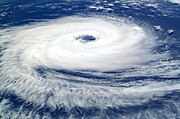
The climate of Brazil comprises a wide range of weather conditions across a large geographic scale and varied topography, but the largest part of the country is tropical.[8] Analysed according to the Köppen system, Brazil hosts five major climatic subtypes: equatorial, tropical, semiarid, highland tropical, and temperate; ranging from equatorial rainforests in the north and semiarid deserts in the northeast, to temperate coniferous forests in the south and tropical savannas in central Brazil.[75] Many regions have starkly different microclimates.[76][77]
An equatorial climate characterizes much of northern Brazil. There is no real dry season but there are some variations in the period of the year when most rain falls.[75] Temperatures average 25 °C (77 °F),[77] with more significant temperature variations between night and day than between seasons.[76] Over central Brazil rainfall is more seasonal, characteristic of a savanna climate.[76] This region is as large and extensive as the Amazon basin but, lying farther south and being at a moderate altitude, it has a very different climate.[75] In the interior Northeast, seasonal rainfall is even more extreme. The semiarid climate region generally receives less than 800 millimetres (31 in) of rain,[78] most of which falls in a period of three to five months [79] and occasionally even more insufficiently, creating long periods of drought.[76] From the south of Bahia, near São Paulo, the distribution of rainfall changes, here some appreciable rainfall occurs in all months.[75] The South has temperate conditions, with average temperatures below 18 °C (64 °F) and cool winters,[77] frosts are quite common, with occasional snowfalls in the higher areas.[75][76]
Wildlife
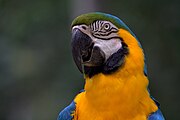
Brazil's large territory comprises different ecosystems, such as the Amazon Rainforest, recognized as having the greatest biological diversity in the world;[80] the Atlantic Forest and the Cerrado, which together sustain some of the world's greatest biodiversity.[81] In the South, the Araucaria pine forest grows under temperate conditions.[81] The rich wildlife of Brazil reflects the variety of natural habitats; however, remains largely unknown, and new species are found on nearly a daily basis.[82]
Scientists estimate that the total number of plant and animal species in Brazil could approach four million.[81] Larger mammals include pumas, jaguars, ocelots, rare bush dogs, and foxes. Peccaries, tapirs, anteaters, sloths, opossums, and armadillos are abundant. Deer are plentiful in the south, and monkeys of many species abound in the northern rain forests.[81][83] Concern for the environment in Brazil has grown in response to global interest in environmental issues.[84]
Its natural heritage is extremely threatened by cattle ranching and agriculture, logging, mining, resettlement, oil and gas extraction, over-fishing, expansion of urban centres, wildlife trade, fire, climate change, dams and infrastructure, water contamination, and invasive species.[80] In many areas of the country, the natural environment is threatened by development.[85] Construction of highways has opened up previously remote areas for agriculture and settlement; dams have flooded valleys and inundated wildlife habitats; and mines have scarred and polluted the landscape.[84][86]
Economy

Brazil is the largest national economy in Latin America, the world's tenth largest economy at market exchange rates[87][88] and the ninth largest in purchasing power parity (PPP),[89][90] according to the International Monetary Fund and the World Bank; with large and developed agricultural, mining, manufacturing and service sectors, as well as a large labor pool.[14] Brazilian exports are booming, creating a new generation of tycoons.[91] Major export products include aircraft, coffee, automobiles, soybean, iron ore, orange juice, steel, ethanol, textiles, footwear, corned beef and electrical equipment.[92] The country has been expanding its presence in international financial and commodities markets, and is regarded as one of the group of four emerging economies called BRIC.[93] The biggest investment boom in history is under way; in 2007, Brazil launched a four-year plan to spend $300 billion to modernise its road network, power plants and ports.[94] Brazil's booming economy is shifting into overdrive, with biofuels and deep-water oil providing energy independence and the government collecting enough cash to irrigate the desert and pave highways across the Amazon Rainforest.[95]
Brazil had pegged its currency, the real, to the U.S. dollar in 1994. However, after the East Asian financial crisis, the Russian default in 1998[96] and the series of adverse financial events that followed it, the Brazilian central bank temporarily changed its monetary policy to a managed-float scheme while undergoing a currency crisis, until definitively changing the exchange regime to free-float in January 1999.[97] Brazil received an International Monetary Fund rescue package in mid-2002 in the amount of $30.4 billion,[98] a record sum at that time. The IMF loan was paid off early by Brazil's central bank in 2005 (the due date was scheduled for 2006).[99] One of the issues the Brazilian central bank is currently dealing with is the excess of speculative short-term capital inflows to the country in the past few months, which might explain in part the recent downfall of the U.S. dollar against the real in the period.[100] Nonetheless, foreign direct investment (FDI), related to long-term, less speculative investment in production, is estimated to be $193.8 billion for 2007.[101] Inflation monitoring and control currently plays a major role in Brazil's Central Bank activity in setting out short-term interest rates as a monetary policy measure.[102]
Components and energy
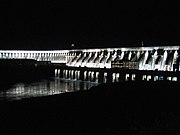
Brazil's "investment grade" economy is diverse,[103] encompassing agriculture, industry, and a multitude of services.[104][105] Brazil is finally punching its weight with a booming economy and stronger global leadership.[106][91] The recent economic strength has been due in part to a global boom in commodities prices with exports from beef to soybeans soaring.[105][106] Agriculture and allied sectors like forestry, logging and fishing accounted for 5.1% of the gross domestic product in 2007.[107] A performance that puts agribusiness in a position of distinction in terms of Brazil's trade balance, in spite of trade barriers and subsidizing policies adopted by the developed countries.[108][109] The industry; from automobiles, steel and petrochemicals to computers, aircraft, and consumer durables; accounted for 30.8% of the gross domestic product.[107] Industry is highly concentrated geographically, with the leading concentrations in metropolitan São Paulo, Rio de Janeiro, Campinas, Porto Alegre, and Belo Horizonte. Technologically advanced industries are also highly concentrated in these locations.[110]
Brazil is the world's tenth largest energy consumer. It's energy comes from renewable sources, particularly hydroelectricity and ethanol; and nonrenewable sources, mainly oil and natural gas.[111] A global power in agriculture and natural resources, Brazil unleash the greatest burst of prosperity has witnessed in three decades.[112] Brazil will become an oil superpower, with massive oil discoveries in recent times.[113][114][115][116] The governmental agencies responsible for energy policy are the Ministry of Mines and Energy, the National Council for Energy Policy, the National Agency of Petroleum, Natural Gas and Biofuels, and the National Agency of Electricity.[117][118]
Science and technology

Brazilian science effectively began in the first decades of the 19th century, when the Portuguese Royal Family, headed by John VI, arrived in Rio de Janeiro, escaping from the Napoleon's army invasion of Portugal in 1807. Until then, Brazil was a Portuguese colony, without universities, and a lack of cultural and scientific organizations, in stark contrast to the former American colonies of the Spanish Empire, which although having a largely illiterate population like Brazil and Portugal, had, however, a number of universities since the 16th century.
Technological research in Brazil is largely carried out in public universities and research institutes. Nonetheless, more than 73% of funding for basic research still comes from government sources.[119] Some of Brazil's most notables technological hubs are the Oswaldo Cruz Institute, the Butantan Institute, the Air Force's Aerospace Technical Center, the Brazilian Agricultural Research Corporation and the INPE. Brazil has the most advanced space program in Latin America, with significant capabilities to launch vehicles, launch sites and satellite manufacturing.[120] On 14 October 1997, the Brazilian Space Agency signed an agreement with NASA to provide parts for the ISS.[121] Uranium is enriched at the Resende Nuclear Fuel Factory to fuel the country's energy demands. Plans are on the way to build the country's first nuclear submarine.[122] Brazil is one of the three countries in Latin America[123] with an operational Synchrotron Laboratory, a research facility on physics, chemistry, material science and life sciences.
Demographics
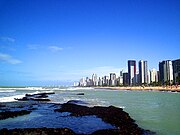
Brazil's population is comprised of many racial and ethnic groups.[124] The last National Research for Sample of Domiciles (PNAD) census revealed the following: 49.7% of the population are White, about 93 million; 42.6% are Pardo (mixed), about 80 million; 6.9% are Black, about 13 million; 0.5% are Asian, about 1 million; and 0.4% are Amerindian, about 519,000.[125] Most Brazilians can trace their ancestry to the country's Indigenous peoples, Portuguese colonists, and African slaves. Since 1500, with the arrival of the Portuguese, miscegenation between these three groups took place. Over three centuries of Portuguese colonization, Brazil received more than 700,000 Portuguese settlers and 4 million African slaves.[126]
Starting in the late 19th century, Brazil opened its doors to immigration: people from over 60 nations emigrated to Brazil. About 5 million European and Asian immigrants arrived between 1870 and 1953, most of them from Italy, Portugal, Spain, and Germany. In the early 20th century, people from Japan and the Middle-East also arrived.[124] The immigrants and their descendants had an important impact in the ethnic composition of the Brazilian population, and many diasporas are present in the country. Brazil has the largest population of Italian origin outside of Italy, with over 25 million Italian Brazilians,[127] the largest Japanese population outside of Japan, with 1.6 million Japanese Brazilians,[128] as well the second largest German population outside of Germany, with 12 million German Brazilians.[129] A characteristic of Brazil is the race mixing. Genetically, most Brazilians have some degree of European, African, and Amerindian ancestry.[130] The entire population can be considered a single "Brazilian" ethnic group, with highly varied racial types and backgrounds, but without clear ethnic sub-divisions.[126]
The largest metropolitan areas in Brazil are São Paulo, Rio de Janeiro, and Belo Horizonte, respectively with 19.7, 11.4, and 5.4 million inhabitants.[131] Almost all the capitals are the largest city in their corresponding state, except for Vitória, the capital of Espírito Santo, and Florianópolis, the capital of Santa Catarina. There are also non-capital metropolitan areas in the states of São Paulo (Campinas, Santos and the Paraíba Valley), Minas Gerais (Steel Valley), Rio Grande do Sul (Sinos Valley), and Santa Catarina (Itajaí Valley).[132]
| Largest cities of Brazil | ||||||||||
|---|---|---|---|---|---|---|---|---|---|---|
| Municipality | Federative unit | Population | Municipality | Federative unit | Population |  São Paulo  Rio de Janeiro  Salvador | ||||
| 1 | São Paulo | São Paulo | 10,990,000 | 11 | Belém | Pará | 1,424,124 | |||
| 2 | Rio de Janeiro | Rio de Janeiro | 7,050,472 | 12 | Guarulhos | São Paulo | 1,279,202 | |||
| 3 | Salvador | Bahia | 2,948,733 | 13 | Goiânia | Goiás | 1,265,394 | |||
| 4 | Brasília | Federal District | 2,557,158 | 14 | Campinas | São Paulo | 1,056,644 | |||
| 5 | Fortaleza | Ceará | 2,473,614 | 15 | São Luís | Maranhão | 986,826 | |||
| 6 | Belo Horizonte | Minas Gerais | 2,434,642 | 16 | São Gonçalo | Rio de Janeiro | 982,832 | |||
| 7 | Curitiba | Paraná | 1,828,092 | 17 | Maceió | Alagoas | 924,143 | |||
| 8 | Manaus | Amazonas | 1,709,010 | 18 | Duque de Caxias | Rio de Janeiro | 864,392 | |||
| 9 | Recife | Pernambuco | 1,549,980 | 19 | Nova Iguaçu | Rio de Janeiro | 855,500 | |||
| 10 | Porto Alegre | Rio Grande do Sul | 1,430,220 | 20 | São Bernardo do Campo | São Paulo | 801,580 | |||
| Source: Brazilian Institute of Geography and Statistics (2008 Demographic Census) | ||||||||||
| ^1 Metropolitan region of São Paulo (São Paulo, Guarulhos and São Bernardo do Campo) ^2 Metropolitan region of Rio de Janeiro (Niterói, Rio de Janeiro, São Gonçalo, Duque de Caxias and Nova Iguaçu) | ||||||||||
Education and health

The Federal Constitution and the 1996 General Law of Education in Brazil (LDB) determine how the Federal Government, States, Federal District, and Municipalities will manage and organize their respective education systems.[12] Each of these public educational systems is responsible for its own maintenance, which manages funds as well as mechanisms and sources for financial resources. The new Constitution reserves 25% of state and municipal taxes and 18% of federal taxes for education.[133][134]
Private school programs are available to complement the public school system. In 2003, the literacy rate was 88% of the population, and the youth literacy rate (ages 15–19) was 93.2%.[133] Illiteracy is highest in the Northeast, around 27%, which has a high proportion of rural poor.[135] Although at same year, Brazil's education had low levels of efficiency by 15-year-old students, particularly in the public school network.[136] Higher education starts with undergraduate or sequential courses, which may offer different specialist choices such as academic or vocational paths. Depending on choice, students may improve their educational background with Stricto Sensu or Lato Sensu postgraduate courses.[137][134]
The public health system is managed and provided by all levels of government, whilst private healthcare fulfills a complementary role.[12][138] There are several problems in the Brazilian health system. In 2006, these were infant mortality, child mortality, maternal mortality, mortality by non-transmissible illness and mortality caused by external causes: transportation, violence and suicide.[139][138]
Language

Portuguese is the official language of Brazil.[10] It is spoken by nearly the entire population and is virtually the only language used in newspapers, radio, television, and for all business and administrative purposes, with the exception of Nheengatu, an indigenous language of South America which has gained the co-official status alongside Portuguese in the municipality of São Gabriel da Cachoeira.[140] Moreover, Brazil is the only Portuguese-speaking nation in the Americas, making the language an important part of Brazilian national identity and giving it a national culture distinct from its Spanish-speaking neighbors.[141]
Brazilian Portuguese has had its own development, influenced by the Amerindian and African languages.[142] Due to this, the language is somewhat different from that spoken in Portugal and other Portuguese-speaking countries, mainly for phonological and orthographic differences. These differences are somewhat greater than those of American and British English.[142] As of 2008, Portugal is considering reforming its own language to accommodate linguistic developments in the Brazilian Portuguese since the two languages diverged.[143]
Minority languages are spoken throughout the vast national territory. Some of these are spoken by indigenous peoples: 180 Amerindian languages are spoken in remote areas. Others are spoken by immigrants and their descendants.[142] There are important communities of speakers of German (mostly the Hunsrückisch, part of the High German languages) and Italian (mostly the Talian dialect, of Venetian origin) in the south of the country, both largely influenced by the Portuguese language.[142][141]
Culture
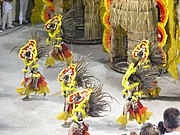
A wide variety of elements create a society with considerable ethnic complexity.[126] Brazilian culture has historically been influenced by European, African, and Indigenous cultures and traditions.[126] Its major early influence derived from Portuguese culture, because of strong colonial ties with the Portuguese empire. Among other inheritances, the Portuguese introduced the Portuguese language, the Catholic religion and the colonial architectural styles.[144] Other aspects of Brazilian culture are contributions of Italian, German and other European immigrants; came in large numbers and their influences are felt closer to the South and Southeast of Brazil.[124] Amerindian peoples influenced Brazil's language and cuisine; and the Africans, brought to Brazil as slaves, influenced language, cuisine, music, dance and religion.[145][124]
Literature in Brazil dates back to the 16th century, to the writings of the first Portuguese explorers in Brazil, such as Pêro Vaz de Caminha, writer of the fleet of navigator Pedro Álvares Cabral.[146] Cuisine varies greatly by region. This diversity reflects the country's mix of native and immigrants. This has created a national cooking style marked by the preservation of regional differences.[147] Brazil's cultural tradition extends to its music styles which include samba, bossa nova, forró, frevo, pagode and many others.[148] Brazil has also contributed to classical music, which can be seen in the works of many composers.[148] In arts, important modern artists Anita Malfatti and Tarsila do Amaral were both early pioneers in Brazilian art.[149] The Cinema has a long tradition, reaching back to the birth of the medium in the late 19th century, and gained a new level of international acclaim in recent years.[150]
The festival of Carnival (Portuguese: Carnaval), with its spectacular street parades and vibrant music, has become one of the most potent images of Brazil;[147] an annual celebration held forty days before Easter and marks the beginning of Lent. Carnival is celebrated throughout Brazil, with distinct regional characteristics, but the most spectacular celebrations outside Rio de Janeiro take place in Salvador, Recife, and Olinda, although the nature of the events varies.[147] Other regional festivals include the Boi Bumbá and Festa Junina (June Festivals).[148][147]
Religion
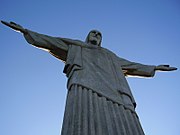
Religion is very diversified in Brazil, the constitution provides for freedom of religion, and the government generally respects this right in practice.[12] The Roman Catholic Church is dominant, making Brazil the largest Catholic nation in the world. [151] The formal link between the state and the Roman Catholicism was severed in the late 19th century; however, the Catholic Church has continued to exert an influence on national affairs.[152]
The number of Protestants is rising. Until 1970, the majority of Brazilian Protestants were members of "traditional churches", mostly Lutherans, Presbyterians and Baptists. Since then, numbers of Pentecostal and Neopentecostal members have increased significantly.[152] Traditional African beliefs, brought by slaves, have blended with Catholicism to create Afro-Brazilian religions such as Macumba, Candomblé, and Umbanda.[151] Amerindians practice a wide variety of indigenous religions that vary from group to group.[152]
According to the 2000 Demographic Census: 73.89% of the population follow Roman Catholicism; 15.41% Protestantism; 0.907% other Christian denominations; 1.332% Kardecist spiritism; 0.309% traditional African religions; 0.010% Amerindian religions; 7.354% agnosticism, atheism or without a religion; and 0.806% other religions. Some of the latter are 0.126% Buddhism; 0.051% Judaism and 0.016% Islam.[153][10]
Sport
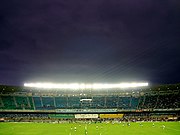
Football (Portuguese: futebol) is the most popular sport in Brazil.[147] The Brazilian national football team (Seleção) is currently ranked second in the world according to the FIFA World Rankings.[154] They have been victorious in the World Cup tournament a record five times, in 1958, 1962, 1970, 1994 and 2002.[155] Basketball, volleyball, auto racing, and martial arts also attract large audiences. Though not as regularly followed or practiced as the previously mentioned sports, tennis, team handball, swimming, and gymnastics have found a growing number of enthusiasts over the last decades. Some sport variations have their origins in Brazil. Beach football,[156] futsal (official version of indoor football)[157] and footvolley emerged in the country as variations of football. In martial arts, Brazilians have developed Capoeira,[158] Vale tudo,[159] and Brazilian Jiu-Jitsu.[160] In auto racing, Brazilian drivers have won the Formula 1 world championship eight times: Emerson Fittipaldi in 1972 and 1974;[161] Nelson Piquet in 1981, 1983 and 1987;[162] and Ayrton Senna in 1988, 1990 and 1991.[163]
Brazil has undertaken the organization of large-scale sporting events: the country organized and hosted the 1950 FIFA World Cup[164] and is chosen to host the 2014 FIFA World Cup event.[165] The circuit located in São Paulo, Autódromo José Carlos Pace, hosts the annual Grand Prix of Brazil.[166] São Paulo organized the IV Pan American Games in 1963,[167] and Rio de Janeiro hosted the XV Pan American Games in 2007.[167] Brazil also tried for the fourth time to host the Summer Olympics with Rio de Janeiro candidature in 2016.[168]




No comments:
Post a Comment